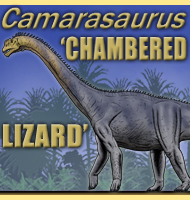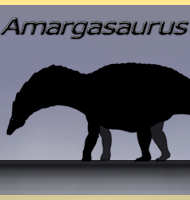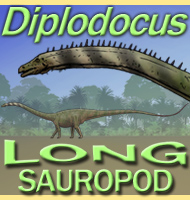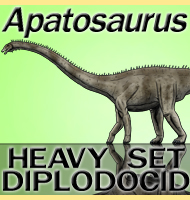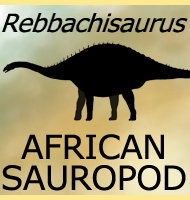


Spinophorosaurus
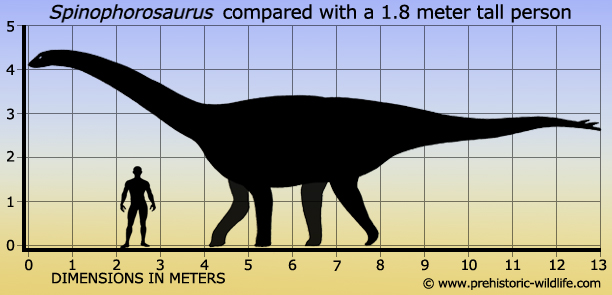
Name:
Spinophorosaurus
(Spine bearing lizard).
Phonetic: Spy-noe-for-o-sore-us.
Named By: K. Remes, F. Ortega, I. Fierro,
U. Joger, R. Kosma & J. N. M. Ferrer - 2009.
Classification: Chordata, Reptilia, Dinosauria,
Saurischia, Sauropoda.
Species: S. nigerensis
(type).
Diet: Herbivore.
Size: About 13 to 14 meters long.
Known locations: Niger, Agadez - Irhazer Group.
Time period: Middle Jurassic, possibly up to
Oxfordian of the late Jurassic. See main text for details.
Fossil representation: Two almost complete
individuals.
Aside
from being one of the best preserved Jurassic era sauropods
from
Africa, the features that really made people sit up and pay attention
about Spinophorosaurus are the spiked osteoderms.
Only a few of these
were found, but the researchers involved with piecing
Spinophorosaurus back together have come to the
conclusion that these
spikes most probably formed a thagomizer-like arrangement upon the end
of the tail, similar to the thagomizers of some stegosaurid
dinosaurs
such as Stegosaurus
and Tuojiangosaurus.
Since the spikes of
Spinophorosaurus were modified osteoderms, they
did not attach
directly to the skeleton, but instead were held in place by the skin
and underlying soft tissues.
Unfortunately
at the time of the description, the age of the Spinophorosaurus
could
not be narrowed down to be any greater than some point between 175
to 161 million years ago. This time period would cover from the
latest early Jurassic, the entire middle Jurassic as well as part of
the first stage of the late Jurassic, the Oxfordian. Further
remains, as well as increased future study and understanding of the
fossil localities may one day yield a more refined age estimate.
Spinophorosaurus
however probably was not unique nor was it the first sauropod dinosaur
to be discovered with a weapon on its tail. During the later stages
of the middle Jurassic, a genus named Shunosaurus
was roaming
around what is now China, and these sauropods had spiked clubs upon
the end of their tails. Interestingly, another genus of sauropod
from the lower middle Jurassic of China named Nebulasaurus
has been
noted as having a very similar braincase to Spinophorosaurus.
Unfortunately Nebulasaurus is still too incomplete
for us to know if
it too had a weaponised tail, but a picture seems to be slowly
emerging of middle Jurassic sauropods across Africa and Asia that were
far from defenceless from potential predators such as theropod
dinosaurs.
Further reading
A new basal sauropod dinosaur from the Middle Jurassic of Niger and the
early evolution of sauropoda - PLoS ONE 4 (9) - K.
Remes, F. Ortega, I. Fierro, U. Joger, R. Kosma
& J. N. M. Ferrer - 2009.
- The braincase of the basal sauropod dinosaur Spinophorosaurus
and 3D
reconstructions of the cranial endocast and inner ear. - PLOS ONE. 7
(1). - F. Knoll, L. M. Witmer, F. Ortega, R. C. Ridgely & D.
Schwarz-Wings - A. A. Farke (ed.) - 2012.
- Spinophorosaurus (Sauropoda), a new look inside
eusauropod evolution.
- Abstract Book of the VI International Symposium About Dinosaurs
Paleontology and Their Environment. Salas de los Infantes Burgos. pp.
89–90. - P. Mocho, F. Ortega, A. Aberasturi & F. Escaso - 2013.
- The specialized tail of Spinophorosaurus nigerensis
(Sauropoda.
Middle Jurassic) and the osteological limits on its range of motion. -
63rd SVPCA (Symposium for Vertebrate Palaeontology and Comparative
Anatomy), At Southampton, England. - D. C. Vidal & F. Ortega -
2015.
- Isolated theropod teeth from the Middle Jurassic of Niger and the
early dental evolution of Spinosauridae. - Acta Palaeontologica
Polonica: 403–415. - A. Serrano-Mart�nez, D. Vidal, L. Sciscio, F.
Ortega & F. Knoll - 2015.
- Assembling a virtual Spinophorosaurus skeleton:
what can it teach us
about the evolution of eusauropods?. - VII Jornadas Internaciones sobre
Paleontolog�a de Dinosaurios y su Entorno. Salas de los Infantes,
Burgos. Burgos. pp. 147–148. - D. Vidal, A. Aberasturi, P. Mocho, F.
Ortega & J. L. Sanz - 2016.
- New information about the appendicular skeleton of Spinophorosaurus
nigerensis (Middle Jurassic, Niger). 16th European
Association of
Vertebrate Paleontologists Meeting, Caparica (Portugal). - European
Association of Vertebrate Palaeontologists. p. 124. - P. Mocho, D.
Vidal, A. Aberasturi, R. Kosma & F. Ortega - 2018.
- Using 3D geometric morphometrics to estimate missing vertebrae in a
Spinophorosaurus dorsal spine (Middle Jurassic,
Niger). 16th European
Association of Vertebrate Paleontologists Meeting, Caparica (Portugal).
- European Association of Vertebrate Palaeontologists. p. 75. - D.
Garc�a-Mart�nez, D. Vidal & F. Ortega - 2018.
- Cases of pathological bone growth in Isanosaurus
and Spinophorosaurus
(Sauropoda). - 5th International Palaeontological Congress – Pierre and
Marie Curie Campus of Sorbonne University; National Museum of Natural
History, Paris, France. - C. Jentgen-Ceschino & K. Stein - 2018.
- High browsing skeletal adaptations in Spinophorosaurus reveal an
evolutionary innovation in sauropod dinosaurs. - Scientific Reports. 10
(1): 6638. - D. Vidal, P. Mocho, A. Aberasturi, J. L. Sanz & F.
Ortega - 2020.
----------------------------------------------------------------------------
Random favourites
 |
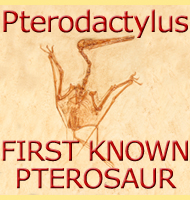 |
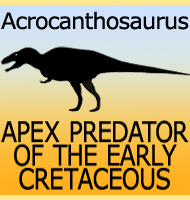 |
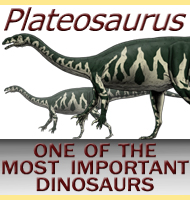 |
